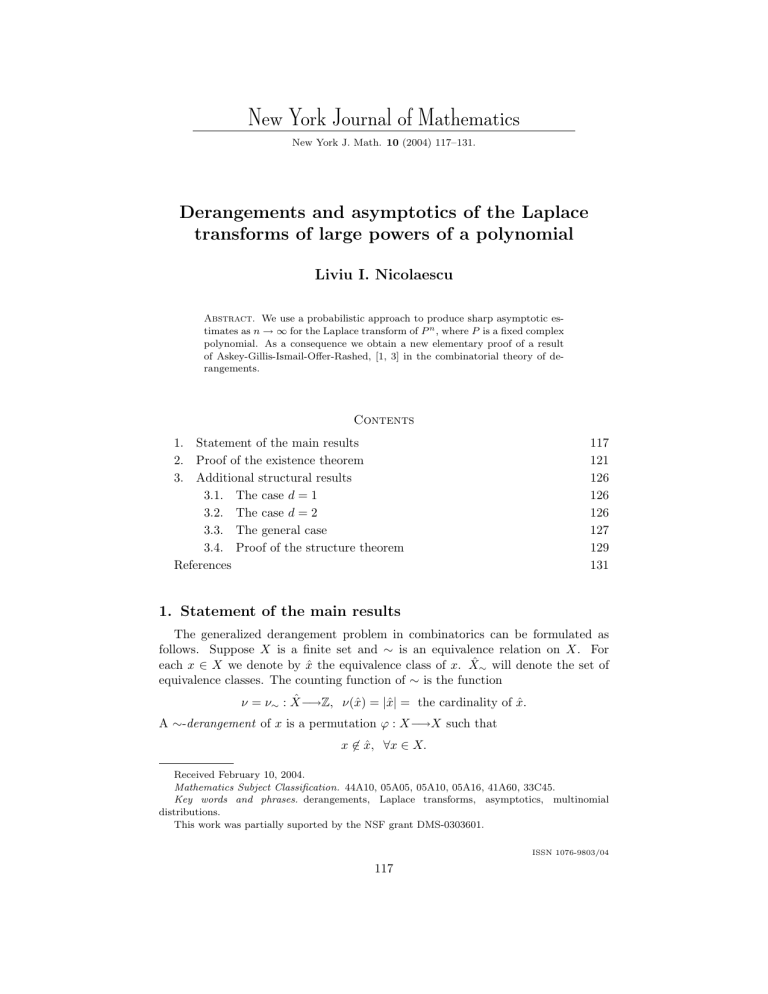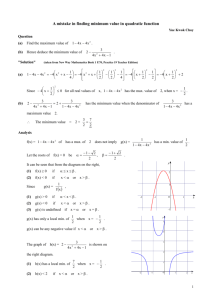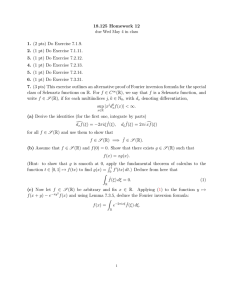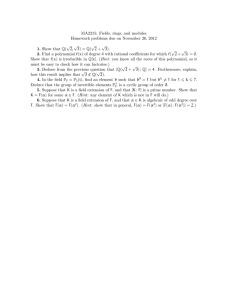New York Journal of Mathematics Derangements and asymptotics of the Laplace
advertisement

New York Journal of Mathematics
New York J. Math. 10 (2004) 117–131.
Derangements and asymptotics of the Laplace
transforms of large powers of a polynomial
Liviu I. Nicolaescu
Abstract. We use a probabilistic approach to produce sharp asymptotic estimates as n → ∞ for the Laplace transform of P n , where P is a fixed complex
polynomial. As a consequence we obtain a new elementary proof of a result
of Askey-Gillis-Ismail-Offer-Rashed, [1, 3] in the combinatorial theory of derangements.
Contents
1.
2.
3.
Statement of the main results
Proof of the existence theorem
Additional structural results
3.1. The case d = 1
3.2. The case d = 2
3.3. The general case
3.4. Proof of the structure theorem
References
117
121
126
126
126
127
129
131
1. Statement of the main results
The generalized derangement problem in combinatorics can be formulated as
follows. Suppose X is a finite set and ∼ is an equivalence relation on X. For
each x ∈ X we denote by x̂ the equivalence class of x. X̂∼ will denote the set of
equivalence classes. The counting function of ∼ is the function
ν = ν∼ : X̂−→Z, ν(x̂) = |x̂| = the cardinality of x̂.
A ∼-derangement of x is a permutation ϕ : X−→X such that
x ∈ x̂, ∀x ∈ X.
Received February 10, 2004.
Mathematics Subject Classification. 44A10, 05A05, 05A10, 05A16, 41A60, 33C45.
Key words and phrases. derangements, Laplace transforms, asymptotics, multinomial
distributions.
This work was partially suported by the NSF grant DMS-0303601.
ISSN 1076-9803/04
117
118
Liviu I. Nicolaescu
We denote by N(X, ∼) the number of ∼-derangements. The ratio
N(X, ∼)
|X|!
p(X, ∼) =
is the probability that a randomly chosen permutation of X is a derangement.
In [2] S. Even and J. Gillis have described a beautiful relationship between these
numbers and the Laguerre polynomials
n n n (−x)k
x d
−x n
, n = 0, 1, . . . .
e
Ln (x) = e
=
x
dxn
k!
k
k=0
For example
L0 (x) = 1, L1 (x) = 1 − x, L2 (x) =
We set
L∼ :=
1 2
(x − 4x + 2).
2!
(−1)ν(c) ν(c)! Lν(c) (x).
c∈X̂
Observe that the leading coefficient of L∼ is 1. We have the following result.
Theorem 1.1 (Even-Gillis).
(1.1)
N(X, ∼) =
∞
e−x L∼ (x)dx.
0
For several very elegant short proofs we refer to [1, 4].
Given (X, ∼) as above and n a positive integer we define (Xn , ∼n ) to be the
disjoint union of n-copies of X
n
X × {k}
Xn =
k=1
equipped with the equivalence relation
(x, j) ∼n (y, k) ⇐⇒ j = k, x ∼ y.
We deduce
(1.2)
p(Xn , ∼n ) =
1
(n|X|)!
0
∞
e−x L∼ (x)
n
dx.
For example, consider the “marriage relation”
(C, ∼), C = {±1}, −1 ∼ 1.
In this case Ĉ consists of a single element and the counting function is the number
ν = 2. Then (Cn , ∼n ) can be interpreted as a group of n married couples. If we set
δn := p(Cn , ∼n )
then we can give the following amusing interpretation for δn .
Couples mixing problem. At a party attended by n couples, the guests were
asked to put their names in a hat and then to select at random one name from that
pile. Then the probability that nobody will select his/her name or his/her spouse’s
name is equal to δn .
119
Derangements and asymptotics
Using (1.2) we deduce
(1.3)
δn =
1
(2n)!
0
∞
e−x x2 − 4x + 2
n
dx.
We can ask about the asymptotic behavior of the probabilities p(Xn , ∼n ) as n → ∞.
In [1, 3], Askey-Gillis-Ismail-Offer-Rashed describe the first terms of an asymptotic
expansion in powers of n−1 . To formulate their result let us introduce the “momenta”
ν(c)r .
νr =
c∈X̂
Theorem 1.2 (Askey-Gillis-Ismail-Offer-Rashed).
(1.4)
ν2
p(Xn , ∼n ) = exp −
ν1
ν1 (2ν3 − ν2 ) − ν22 −1
1−
n + O(n−2 )
2ν13
as n → ∞.
For example we deduce from the above that
1 −1
−2
−2
δn = e
1 − n + O(n ) , n → ∞.
(1.5)
2
The proof in [3] of the asymptotic expansion (1.4) is based on the saddle point
technique applied to the integrals in the RHS of (1.2) and special properties of the
Laguerre polynomials. The proof in [1] is elementary but yields a result less precise
than (1.4).
In this paper we will investigate the large n asymptotics of Laplace transforms
z dn+1 ∞ −zt
Fn (Q, z) =
(1.6)
e Q(t)n dt, Re z > 0,
(dn)! 0
where Q(t) is a degree d complex polynomial with leading coefficient 1. If we denote
by L[f (t), z] the Laplace transform of f (t)
∞
L[f (t), z] =
e−zt f (t)dt
0
then
Fn (Q, z) =
L[Q(t)n , z]
.
L[tdn , z]
The estimate (1.4) will follow from our results by setting
z = 1, Q = L∼ .
To formulate the main result we first write Q as a product
Q(t) =
d
(t + ri ).
i=1
We set
1 s
r .
d i=1 i
d
r = (r1 , . . . , rd ) ∈ Cd , μs = μs (r) =
120
Liviu I. Nicolaescu
Theorem 1.3 (Existence theorem). For every Re z > 0 we have an asymptotic
expansion as n → ∞
∞
Fn (Q, z) =
(1.7)
Ak (z)n−k .
k=0
Above, the term Ak (z) is a holomorphic function on C whose coefficients are universal elements in the ring of polynomials C(d)[μ1 , μ2 , . . . , μk ], where C(d) denotes
the field of rational functions in the variable d = deg Q.
The proof of this theorem is given in the second section of this paper and it is
probabilistic in flavor. In the third section we compute the terms Ak in some cases.
For example we have
1 μ1 z 2
e (μ1 − μ2 )z 2 ,
A0 (z) = eμ1 z , A1 (z) =
(1.8)
2d
and we can refine (1.5) to
1
23
(1.9)
δn = e−2 1 − n−1 − n−2 + O(n−3 ) , n → ∞.
2
96
These computations will lead to a proof of the following result.
Theorem 1.4 (Structure theorem). For any k and any degree d we have
Ak (z) = eμ1 z Bk (z),
where Bk ∈ C(d)[μ1 , . . . , μk ][z] is a universal polynomial in z with coefficients in
C(d)[μ1 , . . . , μk ].
The formulæ (1.8) have an immediate curious consequence which was mentioned
as an open question in [3].
Corollary 1.5. Suppose P (t) = td + atd−1 + · · · is a degree d polynomial with real
coefficients. Then
∞
e−t P (t)n dt > 0, ∀n
0.
0
Notations. A d-dimensional (multi )index will be a vector α
∈ Zd≥0 . For every
d
we define
vector x ∈ C and any d-dimensional index α
αd
1
x α = xα
α| = α1 + · · · + αd , S(x) = x1 + · · · + xd .
1 . . . xd , |
If n = |
α| then we define the multinomial coefficient
n
n!
:= d
.
α
i=1 αi !
These numbers appear in the multinomial formula
n
x α .
S(x)n =
α
|
α|=n
Acknowledgments I want to thank Adam Boocher, a high school student attending the Math Club I was organizing, for asking me if I know how to solve the
Couples Mixing Problem. The present paper grew out of my attempts to answer
his question. I also want to thank the referee for making available to me the hard
to get reference [1].
121
Derangements and asymptotics
2. Proof of the existence theorem
The key to our approach is the following elementary result.
Lemma 2.1. If P (x) = pm tm +· · ·+p1 t+p0 is a degree m with complex coefficients
then for every Re z > 1 we have
pa z b
L[P (t), z]
z m+1 ∞ −zt
(2.1)
.
e
P
(t)dt
=
=
m
L[tm , z]
m! 0
b!
a
a+b=m
Proof.
z m+1
m!
∞
0
e−zt P (t)dt =
∞
m
z m+1 pa
e−zt ta dt
m! a=0
0
=
m
a!
z m+1 pa a+1 =
m! a=0 z
a+b=m
pa z b
.
m
b!
a
Denote by Q(n, a) the coefficient of ta in Q(t)n . From (2.1) we deduce
Fn (Q, z) =
(2.2)
Q(n, a) z b
.
dn
b!
a
a+b=dn
Using the equality
Qn =
n
n j k
t ri
i
j+k=n
d
i=1
(t+ri )n
we deduce that if a + b = dn then
Q(n, a) =
(2.3)
d n
|
α|=b
i=1
αj
r α .
For |
α| = b we set
B(n, α
) :=
d n
i=1
αj
, Pn,b (
α) :=
B(n, α
)
dn
b
α) = r α ,
, ρb (
so that
(2.4)
Fn (Q, z) =
a+b=dn
|
α|=b
Pn,b (
α)ρb (
α)
Observe that we have
(2.5)
Pn,b (
α) =
d
i=1 (1
− n1 ) · · · (1 −
b−1
k=1 (1
−
k
dn )
αi −1
n )
·
·
zb
.
b!
1 b
.
db α
:=Pb (
α)
122
Liviu I. Nicolaescu
The coefficients Pb (
α) define the multinomial probability distribution Pb on the set
of multiindices
∈ Zb≥0 ; |
α| = b .
Λb = α
For every random variable ζ on Λb we denote by Eb (ζ) its expectation with respect
to the probability distribution Pb . For each n we have a random variable ζn,b on
Λb defined by
d
i=1 (1
ζn,b (
α) =
− n1 ) · · · (1 −
b−1
k=1 (1
−
αi −1
n )
k
dn )
ρb (
α).
Form (2.4) and (2.5) we deduce
(2.6)
Fn (Q, z) =
Eb (ζn,b )
a+b=dn
zb
.
b!
To find the asymptotic expansion for Fn we will find asymptotic expansions in
powers of n−1 for the expectations Eb (ζn,b ) and them add them up using (2.6).
For every nonnegative integer α we define a polynomial
1
if α = 0, 1
Wα (x) =
α−1
(1
−
jx)
if α > 1.
j=1
For a d-dimensional multiindex α
we set
Wα (x) =
d
Wαi (x).
i=1
We can now rewrite (2.5) as
Pn,b (
α) = Pb (
α)
Wα ( n1 )
1 .
Wb ( dn
)
We set
α, x) = Wα (x), Kb (
α, x) =
Rb (
1
Rb (
α, x)ρb (α).
Wb ( xd )
We regard the correspondences
α
→ Rb (
α, x), Kb (
α, x)
as random variables Rb (x) and Kb (x) on Λb valued in the field of rational functions.
We deduce
ζn,b = Kb (n−1 ).
Observe
Eb (x) = Eb (Kb (x)) =
1
Eb (Rb (x)).
Wb (x)
From the fundamental theorem of symmetric polynomials we deduce that the expectations Eb (Rb (x)) are universal polynomials
Eb (Rb (x)) ∈ C[μ1 , . . . , μb ][x], degx Eb (Rb (x)) ≤ b − d,
123
Derangements and asymptotics
whose coefficients have degree b in the variables μi , deg μi = i. We deduce that
Eb (x) has a Taylor series expansion
Eb (x) =
Eb (m)xm
m≥0
such that Eb (m) ∈ C(d)[μ1 , . . . , μb ]. The rational function x → Kb (
α, x) has a
d
Taylor expansion at x = 0 convergent for |x| < b−1
so the above series converges
d
for |x| < b−1
. We would like to estimate the size of the coefficients Eb (m). The
tricky part is that the radius of convergence of Eb (x) goes to zero as b → ∞.
Lemma 2.2. Set
R = max |ri |.
1≤i≤d
There exists a constant C which depends only on R and d such that for every b ≥ 0
b
and every 1 ≤ λb < b−1
we have the inequality
m
bb−1
b
Cb
|Eb (m)| ≤
(2.7)
.
λb d
(b − 2)! 1 − λb b−1
b
Proof. Note first that
|ρb (
α)| ≤ Rb , ∀|
α| = b.
For b = 0, 1 we deduce form the definition of the polynomials Wα that Eb (x) = 1.
Fix m and b > 1. Using the Cauchy residue formula we deduce
1
1
d
√
Eb (m) =
E (x)dx, = λb · .
m+1 b
x
b
2π −1 |x|=
Hence
|Eb (m)| ≤
1
bm R b
· max Eb (Rb (x)).
sup
|E
(x)|
≤
b
m |x|=
(λb d)m min|x|= |Wb (x/d)| |x|=
Next observe that
Wb (x/d) = (b − 1)!
b−1
k=1
from which we conclude
min |Wb (x)| = Wb () =
|x|=
1
− x/d ,
k
b−1
k=1
1−
kλb
b
/d < 1/k, ∀k ≤ b − 1,
=
1
bb−1
b−1
(b − kλb )
k=1
(b − 2)!(1 − λb b−1
b )
.
bb−1
To estimate Eb (Rb (x)) from above observe that for every 1 ≤ k ≤ (b − 1) and
|x| = we have
kλb d
|1 − kx| ≤ 1 + k|x| = 1 +
< 1 + d.
b
This shows that for every |
α| = b and |x| = we have
≥
|Rb (
α, x)| < (1 + d)b .
The lemma follows by assembling all the facts established above.
124
Liviu I. Nicolaescu
Define the formal power series
Am (z) :=
Eb (m)
b≥0
zb
∈ C[[z]].
b!
The estimate (2.7) shows that this series
converges for all z.
For every formal power series f = k≥0 ak T k and every nonnegative integer
we denote by JT (f ) its -th jet
JT (f ) =
ak T k .
k=0
For x = n
−1
we have
⎛
⎞
zb
zb
⎝
Eb (x) =
Eb (m)xm ⎠
b!
b!
Fx (z) = Fn (Q, z) =
b≤d/x
=
⎛
⎝
m≥0
b≤d/x
b≤d/x
m≥0
⎞
zb ⎠ m
x =
Eb (m)
Jzd/x (Am (z))xm .
b!
m≥0
Consider the formal power series in x with coefficients in the ring C{z} of convergent
power series in z
F∞ (z) =
Am (z)xm ∈ C{z}[[x]].
m≥0
≥ 0 and every z ∈ C we have
We will prove that for every
|Fn (z) −
(2.8)
Jx F∞ (z)|
= O(n−−1 ), as n → ∞.
To prove this it is convenient to introduce the “rectangles”
Du,v = (b, m) ∈ (Z≥0 )2 ; b ≤ u, m ≤ v .
In this notation we have (x = n−1 )
Fn (z) =
Eb (m)xm
(b,m)∈Dn,∞
zb
,
b!
Fn (z) −
=
b≤dn
m>
m
Eb (m)x
S1 (n)
Eb (m)xm
(b,m)∈D∞,
Then
Jx F∞ (z)
Jx F∞ (z) =
zb
+
b!
m≤
zb
.
b!
zb
xm .
Eb (m)
b!
b>dn
S2 (n)
We estimate each sum separately. Using (2.7) with a λb > 1 to be specified later
we deduce
bx m
C b bb−1
m
|Eb (m)x | ≤
.
λb d
(b − 2)!(1 − λb b−1
b ) m>
m>
125
Derangements and asymptotics
The inequality b ≤ dn can be translated into
convergent for b ≤ dn whenever λb > 1 so that
bx
d
C b bb−1
|Eb (m)x | ≤
(b − 2)!(1 − λb b−1
b )
m>
≤ 1 so that the above series is
m
bx
λb d
+1
1
.
1 − λbx
bd
When b ≤ dn we have
1−
bx
1
>1− .
λb d
λb
If we choose
λb =
we deduce
1 − λb
and, since
bx
λb d
b 1/2
b−1
b − 1 1/2
b−1
1
=1−
=⇒
<b
b
b
1 − λb b−1
b
≤ db x,
1
1
<
< 2b.
bx
1 − λ1b
1 − λb d
Using the inequalities
k! >
k k
e
, ∀k > 0
we conclude that for b ≤ dn we have
|Eb (m)xm | ≤ C1b b+2 x+1 .
Since the series
b≥0
m>
b
C1b b+2 zb! converges we conclude that
S1 (n) = O(x+1 ).
To estimate the second sum we choose λb = 1 in (2.7) and we deduce
Eb (m) ≤ C3b .
Hence
(|C3 |z|)b−2
z b (C3 |z|)b b2
< (2C3 |z|)2
.
Eb (m) ≤
b! b!
(b − 2)!
b>dn
b>dn
Using Stirling’s formula we deduce that for fixed z we have
(|C3 |z|)b−2
< C4 (z)n−−1 .
(b − 2)!
b>dn
Hence
|S2 (n)| ≤ C4 (z)( + 1)n−−1 .
This completes the proof of (2.8) and of Theorem 1.3.
126
Liviu I. Nicolaescu
3. Additional structural results
3.1. The case d = 1. Hence Q(t) = (t + μ1 ) so that
∞
∞
n!
−zt
n
μ1 z
e (t + μ1 ) dt = e
e−zt tn dt = eμ1 z n+1 .
z
0
0
Hence in this case
Fn (z) = eμ1 z
and we deduce
A0 (z) = eμ1 z , Ak (z) = 0, ∀k ≥ 1.
3.2. The case d = 2. This is a bit more complicated. We assume first that
μ1 = 0 so that
Q(t) = t2 − σ 2 .
Then
(−1)k σ 2(n−k)
Q(n, a) =
0
n
k
if a = 2k
if a is odd,
and we deduce
Fn (z) =
=
n
(−1)b
b=0
n
b=0
n
n−b
2n
2n−2b
n!(2n − 2b)! (−1)b (σz)2b
(σz)2b
=
(2b)!
(n − b)!(2n)!
b!
n
b=0
n(n − 1) · · · (n − b + 1) (−1)b (σz)2b
2n(2n − 1) · · · (2n − 2b + 1)
b!
n
1 −b (1 − 1/n) · · · (1 − (b − 1)/n) (−1)b (σz)2b
=
n
22b
(1 − 1/(2n) · · · (1 − (2b − 1)/(2n)
b!
b=0
(σz ) 2
1
1
= 1 − n−1
2
1 − 1/(2n) 2!
(σz)4
1 −2
(1 − 1/n)
+ ··· .
+ 4n
2
(1 − 1/(2n))(1 − 2/(2n))(1 − 3/(2n)) 4!
To obtain Ak (z) we need to collect the powers n−k . The above description shows
that the coefficients of the monomials z 2b contain only powers n−k , k ≥ b. We
conclude that Ak (z) is a polynomial and
degz Ak (z) ≤ 2k.
Let us compute the first few of these polynomials. We have
(σz)4
1
1
1
(σz)2
+ 4 n−2 1 + · · ·
+ ··· .
Fn (z) = 1 − n−1 1 + n−1 + · · ·
2
2
2!
2
4!
We deduce
1
1
1
A0 (z) = 1, A1 (z) = − (σz)2 , A2 (z) = − (σz)2 + 4 (σz)4 .
4
8
2 4!
If μ1 = 0 so that
Q(t) = (t + r1 )(t + r2 ),
r1 + r2 = 2μ1 ,
127
Derangements and asymptotics
then we make the change in variables t = s − μ1 so that
Q(t) = P (s) = s2 − r2 ,
σ 2 = (r1 − μ1 )2 =
(r1 − r2 )2
.
4
Now observe that
4μ21 + (r1 − r2 )2 = (r1 + r2 )2 + (r1 − r2 )2 = 2(r12 + r22 ) = 4μ2
so that
σ 2 = μ2 − μ21 .
Then
Fn (Q, z) =
z 2n+1
(2n)!
0
∞
e−zt Q(t)n =
z 2n+1
(2n)!
∞
0
e−z(s−μ1 ) P (s)n ds = eμ1 z Fn (P, z).
We deduce
(3.1)
1
eμ1 z
1
(σz)2 , A2 (z) = eμ1 z − (σz)2 + 4 (σz)4 .
4
8
2 4!
For the couples mixing problem we have
A0 (z) = eμ1 z , A1 (z) = −
Q(t) = t2 − 4t + 2
so that
1
4
1
1
= −2, σ 2 = (r1 − r2 )2 =
(r1 + r2 )2 − 4r1 r2 = (16 − 8) = 2,
2
4
4
4
and we deduce
1
23
δn = Fn (Q, z = 1) = e−2 1 − n−1 − n−2 + O(n−3 ) .
(3.2)
2
96
3.3. The general case. Let us determine the coefficients A0 (z) and A1 (z) for
general degree d. We use the definition
zb
Ak (z) =
Eb (k) .
b!
μ1 = −
b≥0
For |
α| = b
d
Wα (x) = Wb,α (x) =
i=1
=1−
Wb (x/d) =
b−1
1
2
d
⎛
⎝
α
i −1
j=1
⎞
(1 − jx)⎠ =
d
⎛
⎛
⎝1 − ⎝
i=1
α
i −1
⎞
j⎠ x + · · · ⎠
j=1
αi (αi − 1) x + · · · .
i=1
(1 + jx/d + · · · ) = 1 +
k=1
b(b − 1)
x + ··· .
2d
Next, compute the expectation of Rb (x)
1
Eb (Rb (x)) = Eb (ρb ) − Eb
2
d
αi (αi − 1)r α
i=1
The multinomial formula implies
Eb (ρb ) = μb1 .
⎞
x + ··· .
128
Liviu I. Nicolaescu
Next
d
Eb
αi (αi − 1)r
α
d
1 b
= b
αi (αi − 1) r α .
d
α
i=1
|
α|=b
i=1
Now consider the partial differential operator
P=
d
ri2
i=1
∂2
.
∂ri2
are eigenvectors of P
d
α
Pr =
αi (αi − 1) r α .
Observe that the monomials r
α
i=1
We deduce
d
Eb
αi (αi − 1)r
α
=
i=1
1
1
PS(r)b = Pμb1 .
b
2d
2
Hence
1
Eb (Rb (x) = μb1 − (Pμb1 )x + · · ·
2
and we deduce
1
b(b − 1)
x + ···
μb1 − (Pμb1 )x + · · ·
1+
2
2d
1 b(b − 1) b
= μb1 +
μ1 − Pμb1 x + · · · .
2
d
Eb (x) =
We deduce A0 (z) = eμ1 z
A1 (z) =
∞
1
μ21 z b
μ2 z 2
1
− Peμ1 z = 1 eμ1 z − Peμ1 z .
2d
(b − 2)! 2
2d
2
b=2
We can simplify the answer some more.
Pμb1
1
b(b − 1)
= b PS(x)b =
d
db
d
ri2
S(x)b−2 =
i=1
b(b − 1)
μ2 μb−2
1 .
d
We conclude that
Peμ1 z =
μ2 z 2 (μ1 z)b−2
μ2 z 2 μ1 z
=
e .
d
(b − 2)!
d
b≥2
Hence
(3.3)
A0 (z) = eμ1 z , A1 (z) =
eμ1 z 2
(μ1 − μ2 )z 2 .
2d
For d = 2 we recover part of the formulæ (3.1).
Derangements and asymptotics
129
3.4. Proof of the structure theorem. Clearly we can assume d > 1. We imitate
the strategy used in the case d = 2. Thus, after the change in variables t → t − μ1
we can assume that μ1 = 0 so that Q(t) has the special form1
Q(t) = td + ad−2 td−2 + · · · + a0 .
Set
T (n, b) :=
Q(n, dn − b)
dn
dn−b
This is a power series in x = n−1 ,
T (n, b) = Tb (x) |x=n−1 ,
Tb (x) =
.
Tb (k)xk .
k≥0
We have
Ak (z) =
Tb (k)
b≥0
zb
,
b!
and we need to prove that Ak is a polynomial for every k. We denote by (b) the
order of the first nonzero coefficient of Tb (x),
(b) = min{k ≥ 0; Tb (k) = 0}.
To prove the desired conclusion it suffices to show that
lim (b) = ∞.
(3.4)
b→∞
= (βd , βd−2 , . . . , β1 , β0 ) we set
For every multiindex β
= dβd + (d − 2)βd−2 + · · · + β1 .
L(β)
Let a := (1, ad−2 , . . . , a1 , a0 ) ∈ Cd and
∈ Zd ; |β|
= n, L(β)
= dn − b .
Bn := β
≥0
We have
T (n, b) =
(3.5)
1
dn
dn−b
·
n β
a .
β
β∈B
n
∈ Bn we have
Now observe that for every multiindex β
− L(β)
= b.
2βd−2 + 3βd−3 + · · · + (d − 1)β1 + dβ0 = d|β|
In particular we deduce
(3.6)
βj ≤
b
b
≤ , ∀0 ≤ j ≤ d − 2
d−j
2
and
2βd + b = 2βd = 2βd−2 + 3βd−3 + · · · + (d − 1)β1 + dβ0
≥ 2βd + 2βd−2 + · · · + 2β1 + 2β0 = 2n
1 A similar reduction trick was used in the proof of [1, Thm. 3], but there the authors follow a
different approach which yields less information on the asymptotic expansion.
130
Liviu I. Nicolaescu
so that
b
.
2
These simple observations have several important consequences.
First, observe that they imply that there exists an integer N (b) which depends
only b and d, such that
n − βd ≤
(3.7)
|Bn | ≤ N (b), ∀n > 0.
Thus the sum (3.5) has fewer than N (b) terms.
Next, if we set |a| := max0≤j≤d−2 |aj | then, we deduce
|a β | ≤ |a|β0 +···+βd−2 ≤ |a|
b(d−1)
2
= C5 (b).
Finally, using the identity
n − βd
n − βd − βd−2
n
n
·
···
=
βd−2
βd−3
β
βd
m
the inequalities (3.7) and m
k ≤ 2 , ∀m ≥ k we deduce
b(d−1)
b(d−1)
n
n
n
2
2
·
2
≤ C6 (b)nb/2
≤
2
≤
b/2 + 1
β
βd
Hence
|β|=n,L(
β)=dn−b
n β b/2
β
a ≤ N (b)C5 (b)C6 (b)n
+1
+1
, ∀n
= C7 (b)nb/2
b.
+1
.
On the other hand
1
dn
dn−b
≤ C8 (b)n−b
so that
|T (n, b)| = |Tb (n−1 )| ≤ C9 (b)nb/2
+1−b
≤ C9 (b)n1−b/2 .
This shows
Tb (k) = 0, ∀k ≤ b/2 − 1
so that
(b) ≥ b/2 − 1 → ∞ as b → ∞.
Remark 3.1. We can say a bit more about the structure of the polynomials
Bk (μ1 , . . . , μd , z) ∈ Rd = C[μ1 , . . . , μd , z], k > 0.
If we regard B as a polynomial in r1 , . . . , rd we see that it vanishes precisely when
r1 = · · · = rd . Note that
r1 = · · · = rd = r ⇐⇒ Q(t) = (t + r)d .
On the other hand
d
d
1 1 1
tk μk =
(ri t)k =
d i=1
d i=1 1 − ri t
k
k≥0
(s:=1/t)
=
s 1
s Q (s)
.
=
d i=1 s + μi
d Q(s)
d
Derangements and asymptotics
131
If Q(s) = (s + r)d we deduce
s
1
s Q (s)
=
=
=
(rt)k .
d Q(s)
s+r
1 − rt
k≥0
This implies that
r1 = · · · = rd ⇐⇒ μji = μij , ∀1 ≤ i, j ≤ k ⇐⇒ μj = μj1 , ∀1 ≤ j ≤ d.
The ideal I in Rd generated by the binomials μj1 −μj is prime since Rd /I ∼
= C[μ1 , z].
Using the Hilbert Nullstelensatz we deduce that Bk must belong to this ideal so
that we can write
Bk (μ1 , . . . , μd , z) = A2k (μ, z)(μ21 − μ2 ) + · · · + Adk (μ, z)(μd1 − μd ).
References
[1] R. Askey, M. Ismail, T. Rashed, A derangement problem, Univ. of Wisconsin MRC Report #
1522, June 1975.
[2] S. Even, J. Gillis, Derangements and Laguerre polynomials, Math. Proc. Camb. Phil. Soc.,
79(1976), 135–143, MR 0392590 (52 #13407), Zbl 0325.05006.
[3] J. Gillis, M.E.H. Ismail, T. Offer, An asymptotic problem in derangement theory, Siam J.
Math. Anal., 21 (1990), 262–269, MR 1032737 (91f:05004), Zbl 0748.05004.
[4] D.M. Jackson, Laguerre polynomials and derangements, Math. Proc. Camb. Phil. Soc., 80
(1976), 213–214, MR 0409204 (53 #12966), Zbl 0344.05005.
Dept. of Mathematics, University of Notre Dame, Notre Dame, IN 46556-4618
nicolaescu.1@nd.edu http://www.nd.edu/˜lnicolae/
This paper is available via http://nyjm.albany.edu:8000/j/2004/10-7.html.






![18.125 Homework 10 : [0, 1] → [0, 1]](http://s2.studylib.net/store/data/010491524_1-2ff13645829ce7088147b1ea2705ee77-300x300.png)
